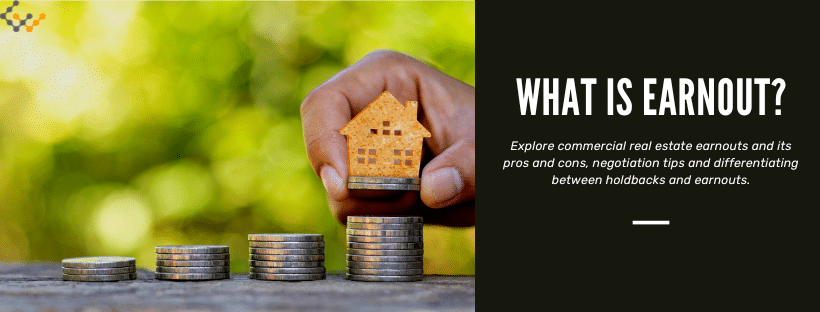What is Earnout on Commercial Loans?

Various situations in commercial real estate may call for earnouts, an opportunity to pull additional money from a real estate asset when specific steps or strategies are completed. There are various situations where property owners may need to refinance their existing loan, but their business plan has not yet reached its expected goals. That is, they may put additional value into the property through renovations that will boost rents.
Consider how an earnout in commercial loans occurs and what it means to investors.
What is Earnout in Commercial Real Estate?
An earnout is a type of provision within a loan agreement. It allows the investor (or loan borrower) to obtain additional capital from the lender. However, it stipulates when this can occur, such as after completing specific goals, objectives, or events. Earnouts can be associated with a range of purposes, including reaching operational performance objectives or, in some situations, obtaining a certificate of occupancy.
When the borrower achieves the specified goal, the lender can increase the loan amount. In their structure within the loan, earnouts are allowable because the new operating performance of the property will allow it to meet qualifications.
Answer a few questions and get custom mortgage quotes. We'll match you with offers from our network of 650+ lenders.
Pros and Cons of Earnouts in Commercial Real Estate
Like all types of loans, investors must consider both the good and bad with an opportunity like this before making an investment.
Pros
The most significant benefit to the investor is that an earnout increases access to additional funding. Along those lines, the investor does not need to go through the entire loan qualifying process. It also works well to keep the costs of obtaining a new loan lower. Instead of paying closing costs and fees, attorney fees, and application fees for a second infusion of capital, the loan is structured to allow for the second draw or access later.
Lenders can typically require that the property’s new value or revenue be able to handle the additional capital because operating performance has improved as the result of some objective goal. This could be due to upgrading tenant income requirements or increasing renovations to boost tenant occupancy.
Cons
Earnouts come with some risk, as do all types of commercial loans. There are situations where there is a risk that the earnout will occur, but the property’s value decreases. If this happens for any reason, the commercial loan is “underwater,” meaning more is owed on the loan than the property is worth if sold on the open market.
In addition to this, investors must consider the increase in costs, including the higher monthly payment when the earnout is paid out. Often, these monthly payments increase substantially at the end of the prior interest-only period. At the point of the earnout being issued, the investor then begins to make payments on both the interest and the principal, which can be a much higher cost, making it more challenging to afford in situations where the property’s value or revenue has not improved.
Investors must take into consideration the requirements of the new loan. Typically, a commercial real estate broker will discuss the structure options to alleviate financial concerns in some situations.
Examples of Commercial Earnout
Consider a few examples of how a commercial earnout would be structured in a commercial loan scenario.
An investor aims to purchase a property with a $5 million loan. The lender funds the loan at $5 million. It then establishes another $1 million to be made available once the borrower converts the property from a 4-tenant space to a 5-tenant space. Initially, the borrower will pay interest only on the loan for a period of time, creating a low initial monthly payment.
When the earnout is paid forward, the loan will incorporate a principal and interest loan payment. Should the investor not enhance the property for any reason, the lender will not provide the additional $1 million in funding.
This type of loan can be structured for various objectives and goals in this manner, including achieving revenue goals, changing formats, or meeting specific performance-related objectives.
3 Tips on How to Negotiate Earnouts in Commercial Loans
Investors considering using a commercial real estate loan typically need to spend some time comparing options carefully and negotiating details based on the specifics of their property. However, there are a few key best practices to keep in mind for any investor moving in the direction of earnouts and holdbacks.
- Understand the terms of the loan. The key here is that the lender defines the terms of any earnout that the borrower must agree upon. If the borrower does not fully understand the scope of the loan, including what criteria must be met for the earnout to be triggered, this can create a financial limitation.
- All costs must be considered. When negotiating an earnout, borrowers must understand all costs involved. This includes interest costs, application fees, and the overall repayment structure. Investors should fully understand the difference in this type of loan structure from other available commercial loans as well.
- The debt service coverage rate and loan-to-value ratio of these loans must be considered. The lender will consider these factors when issuing a determination on the loan. Investors, then, should be able to provide this information early on to ensure the lender can make a favorable decision.
Most importantly, investors considering an earnout structure to a loan like this should realize they have the ability to negotiate. Lenders who wish to be a part of these types of projects, which are typically beneficial to the lender as well as the borrower, will work closely with borrowers to structure loans that are favorable to all involved. The key here is to ask for a better offer.
Holdback vs Earnouts: What’s the Difference?
A secondary term often used in commercial real estate loans like this is a holdback. A holdback occurs when the commercial lender will maintain or hold back a part of the loan proceeds at the time of the loan closing. In this situation, the lender is providing the total loan value requested but only provides the investor with a specific amount of that loan until some type of objective is accomplished.
The difference between a holdback and an earnout is that an earnout is only a promise to offer additional capital. The lender is not obligated to do so. In the holdback structure, by comparison, the borrower is paying interest on the total proceeds to be received from the start, and that typically includes the holdback amount, even though the borrower does not have full access to these funds just yet.
Wrapping Up
When considering any commercial real estate purchase, the investors must determine the best way to structure loans and borrowed funds to keep costs low but access to necessary capital high. Earnouts can be one way to achieve this objective. When negotiated to the best possible terms, they can be a valuable tool for purchasing and improving commercial real estate across all sectors.

